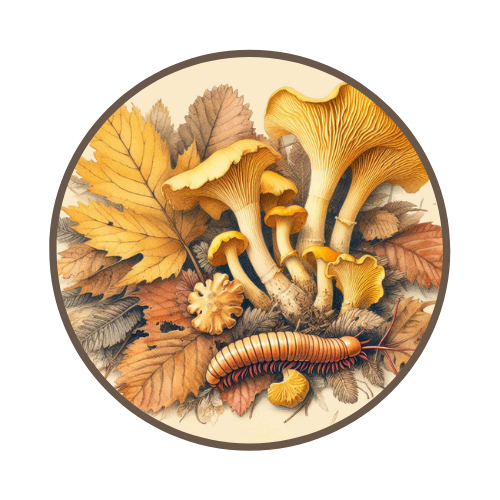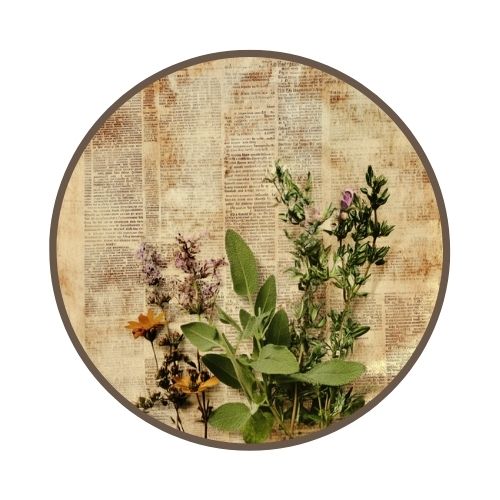Gardens are wonderous ecosystems where the destinies of plants, bugs, and fungi intertwine in a harmonious dance of life. Each element plays a crucial role, creating a balanced and thriving environment. Plants provide food and shelter, while bugs such as bees and butterflies pollinate flowers, ensuring the continuation of plant species. Fungi work behind the scenes, breaking down organic matter and enriching the soil with essential nutrients. This intricate web of interactions showcases the remarkable synergy and interdependence within nature, highlighting the delicate balance that sustains the beauty and vitality of gardens.
The theme for our 2024 Almanac was Kismet. Kismet is the idea of fate or destiny. It is often used to describe the belief that certain events in one’s life are predetermined and beyond individual control. The term is derived from the Turkish word "kısmet," which means "portion" or "fate." On a deeper level, kismet encompasses the notion that life is influenced by a higher power or cosmic order that directs personal journeys and relationships. People often use the term to express the feeling that unexpected events or encounters are meant to happen or are guided by destiny. Kismet symbolizes the interconnectedness of events and experiences that shape a person's life. It embodies the idea of serendipity, where moments of chance can lead to significant outcomes. In literature and storytelling, kismet can serve as a narrative device to illustrate how characters’ lives are entwined by forces beyond their control, reinforcing themes of fate, love, and the unpredictability of life.
Gardens and ecosystems are intricate systems that reflect the principles of interconnectedness. Both serve as microcosms of natural environments, offering insights into how organisms interact, compete, and coexist. We wanted to highlight the importance of interaction between plants, bugs, fungi, and trees for each season.
Autumn
Bugs- Centipedes and Millipedes
Although people generally lump them in the same group, Centipedes and Millipedes are different species. Centipedes are carnivores and don't have as many legs. In contrast, Millipedes are vegetarians and have lots more legs. Many people view these unsettling bugs as pests to eliminate when they actually benefit any ecosystem!
Millipedes are scavengers and feed primarily on decaying vegetation and leaf litter. They spend most of their lives in the soil. They play a crucial role in composting and decomposition, breaking down plants, and returning nutrients to the soil. Millipedes live harmoniously with other bugs. Their primary defense is stink glands they use as a warning, as they are poisonous to those who want to eat them. They also have a hard exoskeleton and will curl into a spiral to protect themselves.
Centipedes are found in various habitats but prefer dark, moist, protected areas such as under stones, logs, leaves, and bark. The most common centipede people see is called a House Centipede, as it often is found in garages or basements. People don't realize that if you are seeing these house centipedes, you're not seeing all the bugs they're eating. They are major pest control, eating all the other bugs you don't want in your home, like cockroach larvae, and termites. For this reason, safely depositing a centipede outside is in your best interest if you find these in your home. They also can take down pests like slugs, snails, fly larvae, and aphids.
Both centipedes and millipedes will want to stay out of your way, so coexisting is easy! They are wonderful companions for the garden!
Fungi
As summer fades away and leaves start to turn, a magical transformation occurs in the fungi world. Fall brings forth a new array of fascinating fungal phenomena and is a favorite time for mushroom enthusiasts and foragers. As the dampness of autumn combines with fallen leaves and decaying wood, it creates the perfect conditions for various mushroom species to flourish. From the iconic and delectable chanterelles to the elusive and prized matsutake, the fall forest becomes a treasure trove of edible fungi. It's a time of excitement and exploration as mushroom enthusiasts venture into the woods, baskets in hand, in search of these elusive treasures.
In the fall, some species of fungi exhibit a fascinating phenomenon known as synchronous fruiting. Multiple fruiting bodies of the same species release their spores simultaneously, creating a mesmerizing display of mushrooms covering the forest floor. This synchronized event is thought to be influenced by environmental cues such as temperature, humidity, and daylight hours, adding a touch of natural wonder to any autumn environment.
Fall is synonymous with falling leaves, and fungi play a crucial role in their decomposition. As leaves carpet the forest floor, fungi eagerly work, breaking down the organic matter and recycling nutrients into the soil. This vital process helps maintain the balance of the ecosystem, enriching the soil and supporting the growth of new life in the following spring. It's a symbiotic dance between fungi and fallen leaves, reminding us of nature's cyclical processes.
While we often associate vibrant colors with changing the leaves, fungi also contribute to the visual spectacle of fall. Many species of mushrooms display an array of captivating colors during this season. From the striking reds and oranges of the fly agaric (Amanita muscaria) to the deep blues and purples of the indigo milk cap (Lactarius indigo), fungi offer a dazzling color palette that adds an extra touch of enchantment to the forest.
In the wake of forest fires, fall unveils the remarkable regenerative power of fungi. Some fungi, such as morel mushrooms, thrive in post-fire landscapes. These fungi play a crucial role in the forest's recovery, assisting in charred vegetation's decomposition and establishing new plant life. Their presence brings hope and renewal to fire-affected areas, showcasing the resilience and adaptability of fungi.
Fungi provide a vital food source for many wildlife species hibernating for winter. Squirrels, deer, and other foragers actively seek out mushrooms as a protein-rich part of their diet. Some species of mushrooms, such as the velvet foot (Flammulina velutipes), are known for their persistence in fall and winter and are happily consumed by omnivorous wildlife when other food sources become scarce. The presence of fungi contributes to the biodiversity and sustenance of ecosystems during the fall.
Plants and trees
Fall is an essential time of the year for your garden, especially for the soil. It is a time to make changes to the form of your trees. It is also time to think about snow and the safety of limbs and growth that could damage the plants under snow load or in a cold snap.
Here are some habits I have with my garden you may like to look into and adopt if it fits you and your garden.
Leaves and debris- I try hard not to use any manufactured fertilizers, so as leaves fall and I cut back ornamental plants for the coming winter, I will cut up and leave debris where I cut it, or if seeds are not an issue, I toss it on the lawn to mow into the grass. Earthworms will consume and leave castings that will feed your garden in the coming spring and summer. This can become part of your mulch layer, saving money and effort over buying and placing new mulch.
Tune in on your water needs. Fall is an excellent time to stop your timers and review your watering habits. Spending time with your plants and learning the signs of water needs will benefit you. Fall is a great time to learn the signs of water needs.
As you watch your garden over the summer, you will note the overgrown plants that could be in better locations. Fall and Spring are the best times to move them. You may have bulbs that could use splitting and spreading out. It’s also a great time to enrich the soil and replant.
The best way to trim your bushes and trees will vary by plant, but fall is generally a good time to prune. It’s a time that the sap slows and nutrients are stored deep in the plant. YouTube is a great resource to learn how to style and grow your plants to your desired shapes. But nothing is like some good old experience. Over time, plants can be forgiving if you make some directional mistakes. Do your research, dive in, and you will quickly get the hang of it. I have found that fear and procrastination can bring a plant past the point of a bit of trim to a massive rework, which could become a risk to the plant’s survival. Be brave and get started.
About the Authors
 |
Birdy Adams Our Customer Service Fairy (AKA Customer Service Representative), she has been taking care of customers with care, compassion, and amazing emails since 2022. Birdy brings joy, positivity, and magic to our customers. She describes herself as creative, optimistic, outdoorsy, animal/nature-loving, friendly, and a hippy/witch. Her favorite herb is Rosemary, and she proudly recommends ClearLungs® Immune and Essential Eyes®. |
 |
Melissa Christensen Our BeeKeeper (AKA Chief Operating Officer), has been beekeeping the team since 2007. Melissa helps keep the office running smoothly, is full of positivity and oversees the health of the company and its employees. She describes herself as positive, amiable, adventurous, witty, and resourceful. Her favorite herb is Dittany of Crete, and she proudly recommends our Gladder Bladder™ (Melissa came up with the name for this one), AdrenaLove®, Essential Eyes®, PhysiQOL™, and SereniZen® Gummies.
|
Check out the other garden kismet guides:
Check out our other blogs on gardening:
- Does the World Need Heirloom Seeds?
- Natural Pest Control
- HugelKultur
- The Basics of Composting
- Fruit Grafting
- Benefits of Vermicomposting
- Naturalizing Your Yard
- Got Weeds?
- Nighttime Blooms & Pollinators
- Natural Soil Amendments
- Companion Planting
- Lost & Forgotten Tips
- Horticulture Therapy: Psychological & Physical Benefits of Gardening
- No Till Gardening
- Container Gardening
- Happy Bees, Happy Garden
- 5 Edible Garden Blooms
- How to Make a Garden Frame
- Compost Tea Recipe
- Medicine Wheel Garden
- Mycelium in the Garden




Leave a comment
All comments are moderated before being published.
This site is protected by hCaptcha and the hCaptcha Privacy Policy and Terms of Service apply.